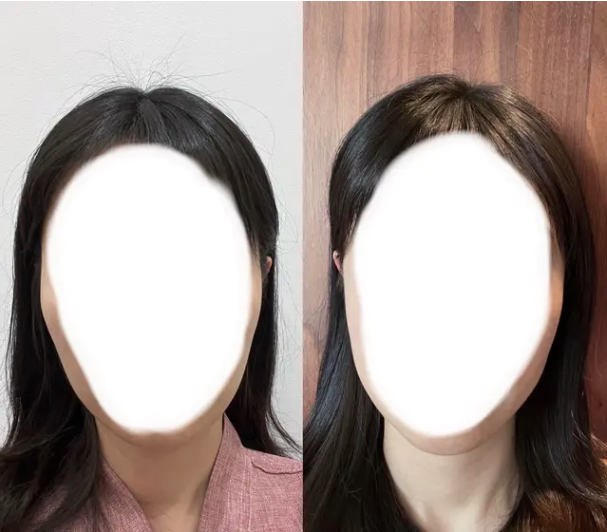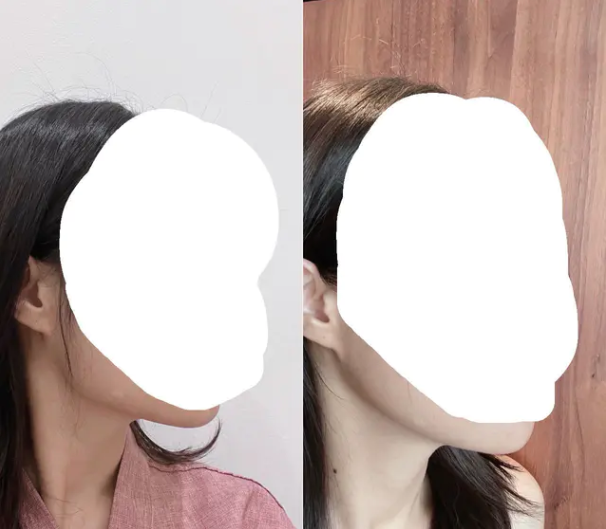Title
Life After Bone Contouring: 2-Month Post-Op ReviewSurgery
Mandible Jaw Reduction, Cheekbone Reduction, GenioplastySurgery Date
2025-04-16Views
576
My Plastic Surgery Story
Date
2025-08-29
Surgery: Facial Bone Contouring All 3-set
After years of reading other people’s jaw reduction stories, it’s finally my turn to share mine (^o^)/!
No long introduction! Let’s start with photos. In the picture, it was taken two months post-surgery. Sometimes there’s still a bit of swelling, but honestly I quite like the slightly puffy look XD
In the two comparison photos below, the left side is pre-op and the right side is post-op.
I had the “three-bone” surgery in Korea, meaning cheekbone + jaw angle + chin reduction. In this post I’ll first share why I decided to do it, then go through the most common questions people usually ask, as well as the questions I myself wanted answers to before surgery. Hopefully that will make everything clearer.
¤ Before & After (2M)


Why I Considered Surgery
Since high school, I was always conscious of my square face. I tried botox injections several times but they didn’t really help, so I just tried to live with it.
In the past two years, another problem appeared—very prominent, protruding cheekbones. When my face was fuller, I didn’t notice it as much. But as collagen disappeared, my temples and cheeks hollowed, making my cheekbones extremely sharp and obvious. That aged me a lot compared to my peers and gave me a harsh, unapproachable look.
Hollow temples, protruding cheekbones, sunken cheeks, and a square jaw… my face felt uneven and bumpy. My appearance anxiety, which I had managed to put aside for years, came back. That’s when I began to seriously consider bone surgery.
Jaw reduction is a major procedure under general anesthesia. I hesitated for a long time and read almost every post I could find online. I kept asking myself—could I live the rest of my life with this face shape? My conclusion was that even with the risks and long recovery, I wanted to try. I wanted to know what it feels like to take a photo without hiding my face.
That was my mindset before surgery. Now, let’s move on to the Q&A. If there are other questions I don’t cover, feel free to leave them in the comments. I’ll answer what I can. Back then, I benefitted so much from other people’s generous sharing, so I hope this post can give something back to anyone with the same worries.
1. How old were am I when I had the surgery?
I was 32. Most people I saw online were in their 20s, so I worried about skin sagging or harder recovery at my age. But after seeing women my age—and even in their 40s—go for it bravely, I gained confidence.
2. Why did I choose Korea?
At first, I leaned toward doing it in Taiwan. I looked into Dr. Kuo, but just for a consultation the earliest available was mid-2027! Surgery would be even further out, and I simply couldn’t wait that long.
Also, after looking at many cases, I felt that Korean surgeons’ aesthetic sense matched my preferences more. So I made the decision to go to Korea.
3. How much did it cost?
I went to A Plastic Surgery Hospital in Korea. Their promotions change all the time. You can contact them through their official website, and if you visit in person, they’ll tell you the discounted price. They told me there are always discounts for in-person visits, but I don’t know the current rate. So please check directly with the hospital.
Flights, accommodation, shopping, etc. will depend on your own budget and habits.
4. How was the consultation?
My surgery was with Dr. Ahn. The consultation was quick but precise. Even though it didn’t take long, I could tell he was cautious and very confident in his technique, which was reassuring.
I brought sample photos of the face shape I wanted. He advised me not to add a chin implant—that keeping my natural length would look younger. That felt very honest, not pushy, and gave me confidence in his judgment.
He also explained how he would operate, showed me nerve distribution, and mentioned that since my nerves were lower, the area of bone he could shave was somewhat limited. I really appreciated this, since it helped manage expectations.
The hospital provided Chinese interpreters throughout, and they were very kind and patient. Communication was never a problem.
5. How long did I stay in Korea?
I stayed 11 days, mainly to remove stitches at my temples (these can be taken out around day 7). Most of the internal stitches are inside the mouth, which can be removed after 14 days. Some people stay in Korea until then; I chose to go back to Taiwan and have them removed at a local plastic surgery clinic.
6. Was it painful?
Like most people, my throat hurt terribly when I woke up—it was the worst pain, but after drinking water and resting, it got much better by the second day.
The bones themselves didn’t hurt, just felt numb while the nerves recovered. Sometimes the stitches inside the mouth ached, but it was tolerable.
7. Post-surgery care tips?
Headband: Absolutely necessary. Different clinics recommend wearing it for 7–14 days. My consultant told me 7 days. When I removed it too long in the first week, my face felt like it would burst, so wearing it was actually more comfortable. Don’t wear it too tight though—it can hurt circulation and cause hair loss.
Food: Stock up on liquids. The first three days, it’s hard to even step outside. Some people go shopping the next day, but if you’re not superhuman, prepare enough food. I stocked up on chicken essence, fish essence, milk, and pumpkin juice. Paper cups with a pointed edge are easier to drink from, or some use syringes.
I only drank liquids for 3 days. By day 4 I felt weak and started eating porridge, which took me 4 hours to finish. Later I ate bananas, tofu, steamed eggs—swallowed rather than chewed, to avoid straining the bones.
Cold compress: I iced diligently for the first 3 days, which helped reduce swelling.
Light activity: Once stronger, try to walk around, even at home. It helps with swelling and recovery.
Breathing exercises: I coughed up blood for about 5 days post-op. Deep breathing helped a lot.
Oral hygiene: Very important. Since most incisions are inside the mouth, keeping clean reduces infection risk. Even after just drinking liquids, rinse your mouth.
Hair washing: For the first week, the wounds can’t touch water. Ideally, go to a salon and have someone wash your hair. I was too embarrassed to go out, so I struggled to wash at home. If possible, get help—it’s much easier.
Final Thoughts
It was tough. I cried out of hunger more than once. But since I had already gathered the courage to undergo surgery, I reminded myself to be patient and take care of my body, because proper recovery is the only way to get proper results.
Now, almost two months post-op, I’ve made it past the hardest stage. People around me say I look younger and my face shape is much smoother. It feels worth every bit of effort.
I hope everyone reading this can also become the version of themselves they want to be. 💕
* Surgical results may vary from person to person. There may be side effects such as bleeding or inflammation. Costs may vary depending on the diagnosis after CT scan and in-person consultation. The rate at which bruising and swelling subside also differs for each individual.





